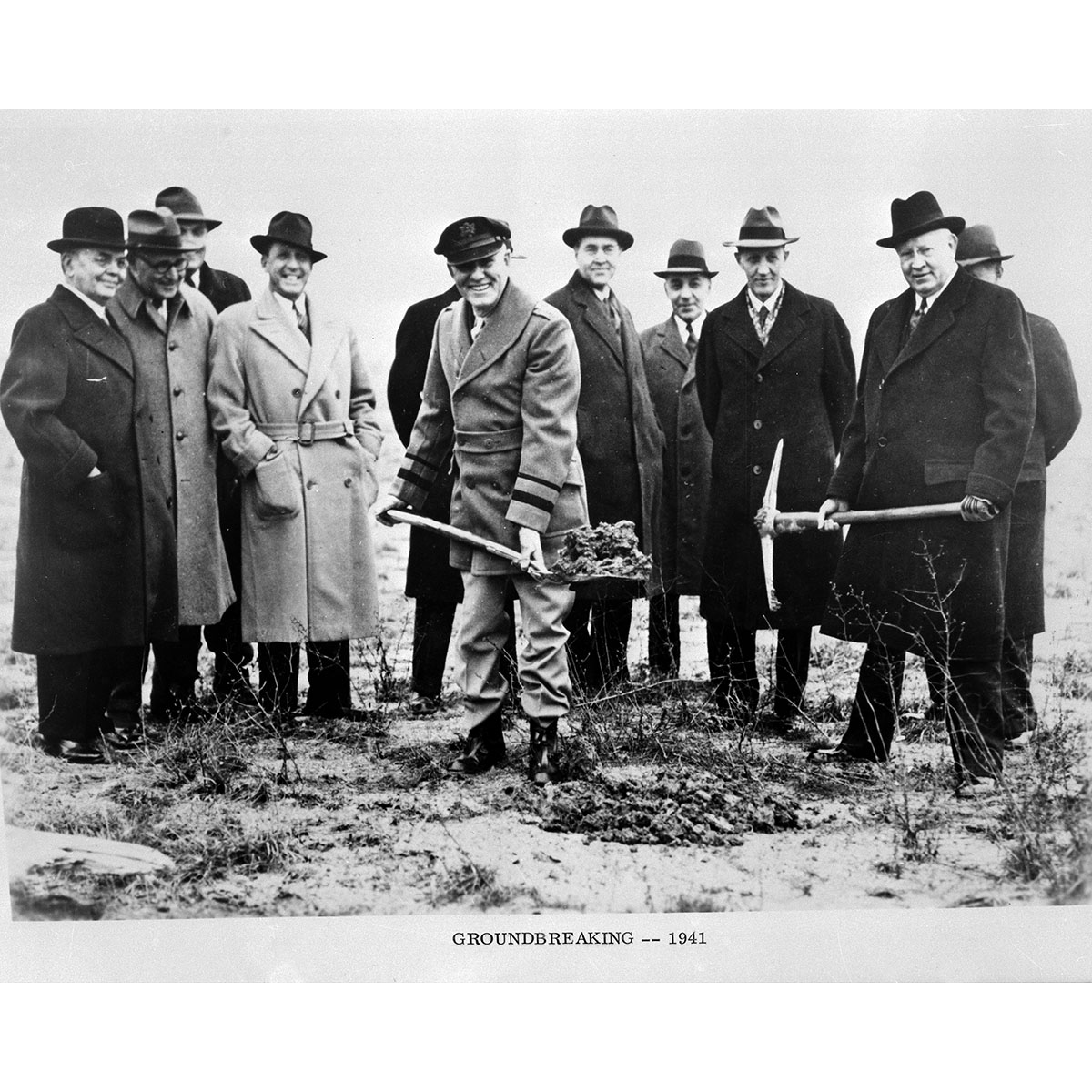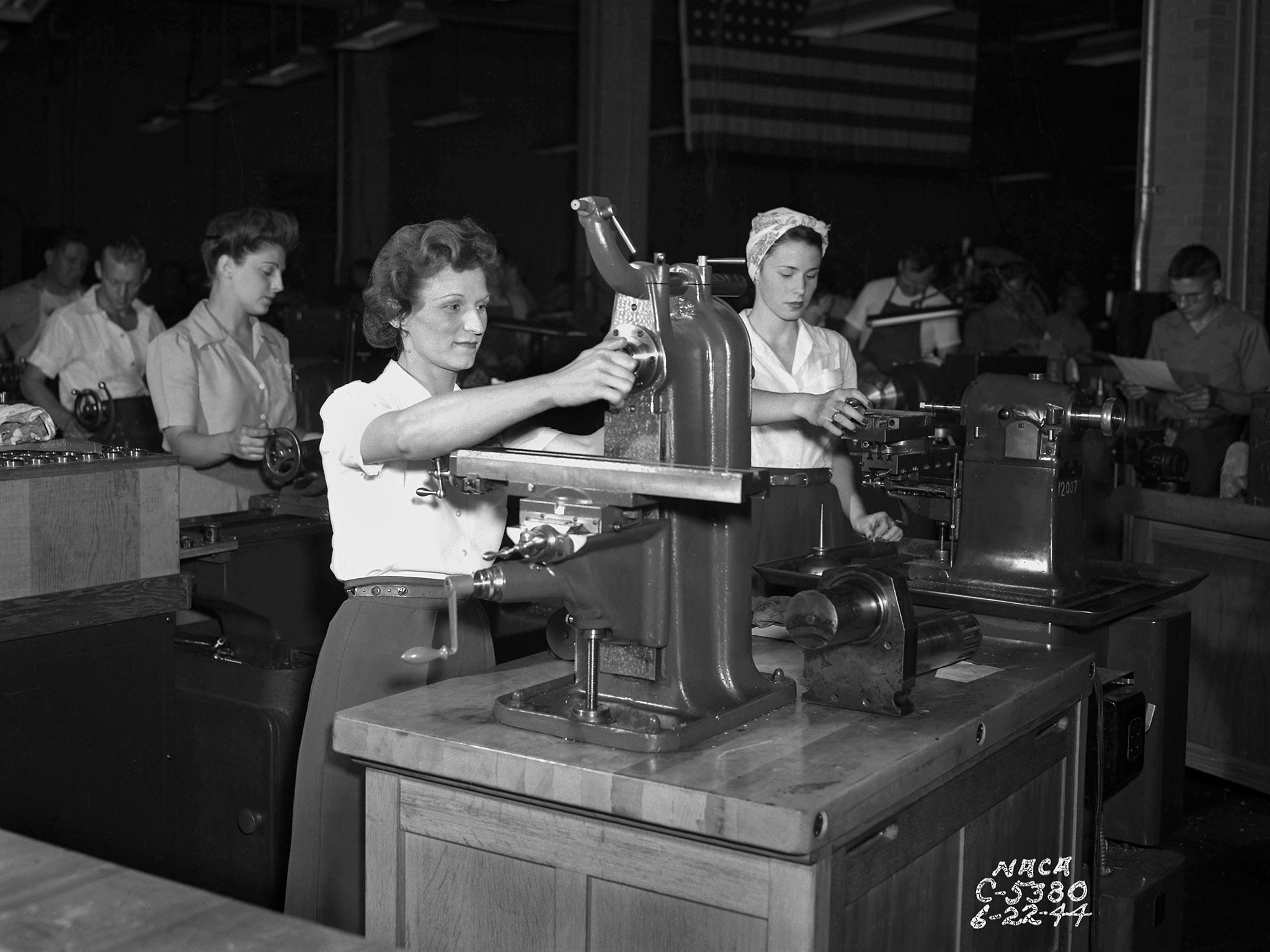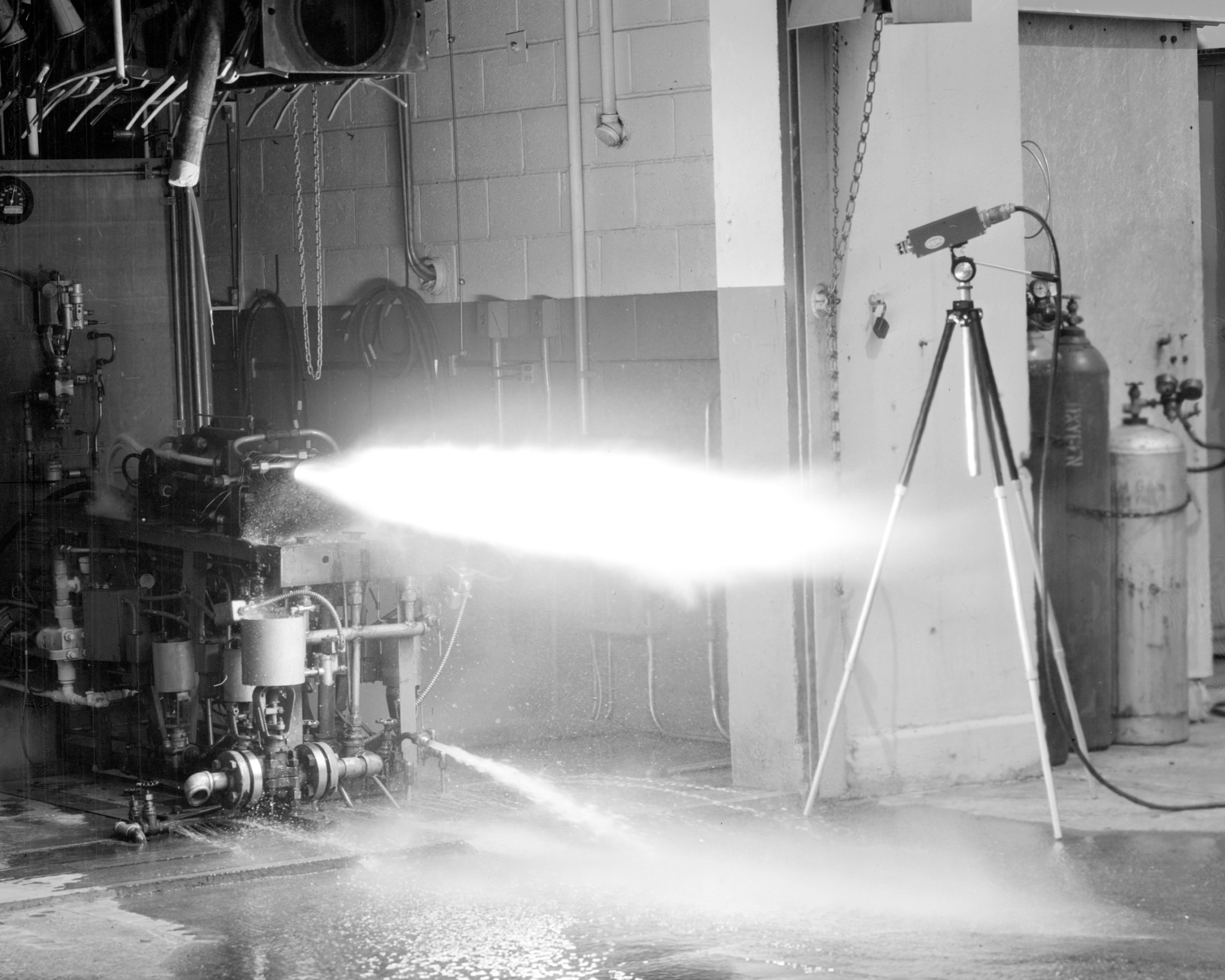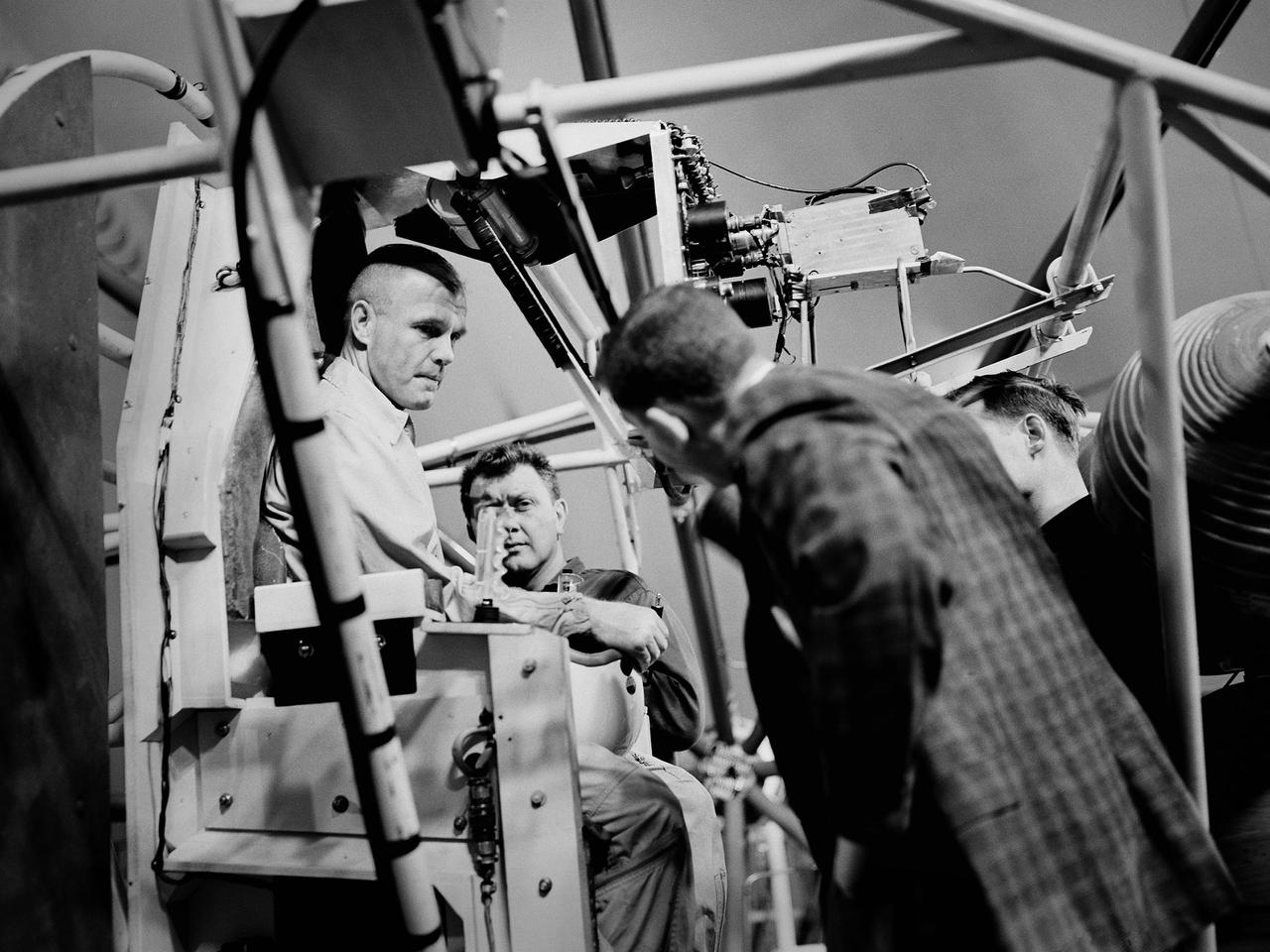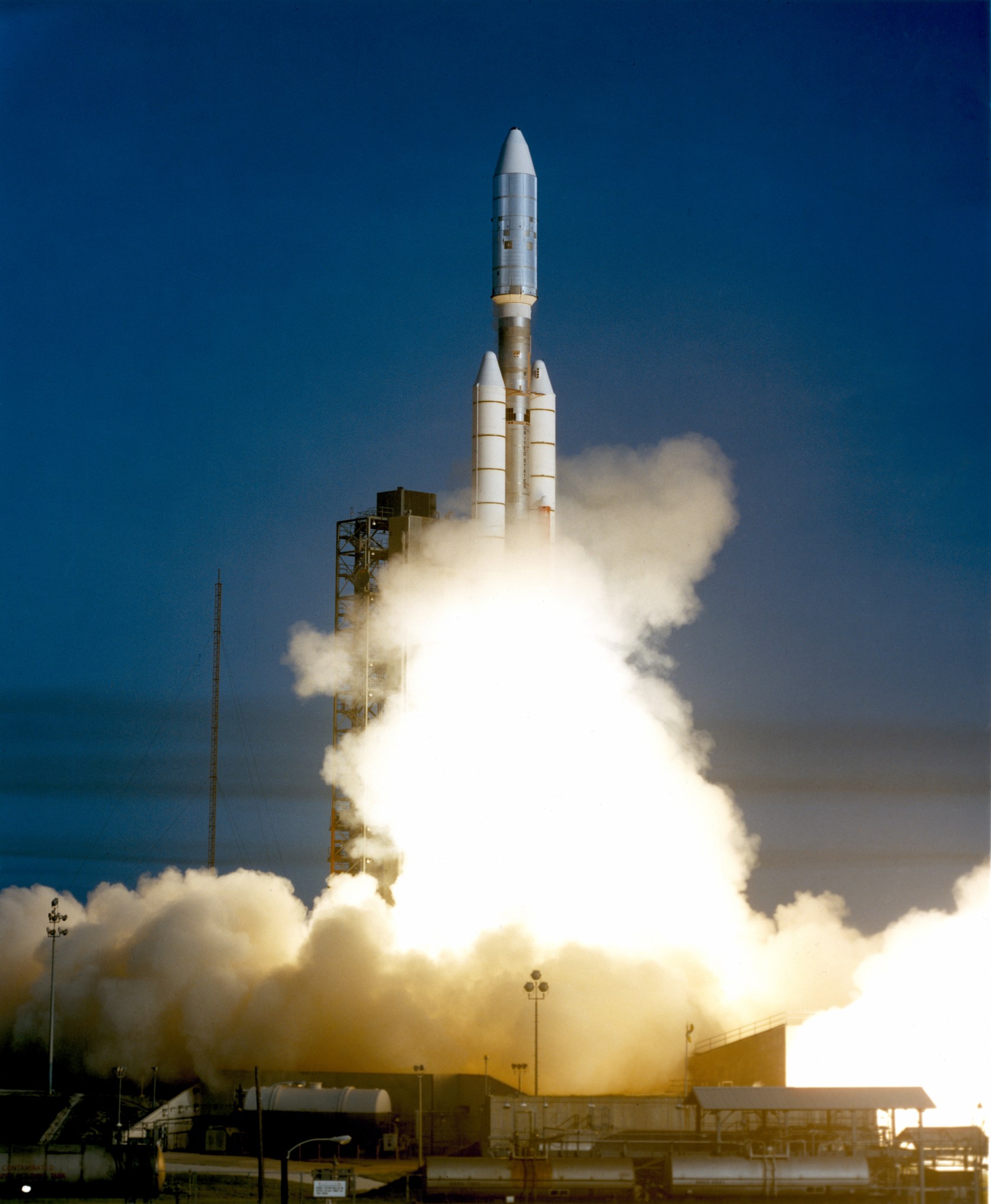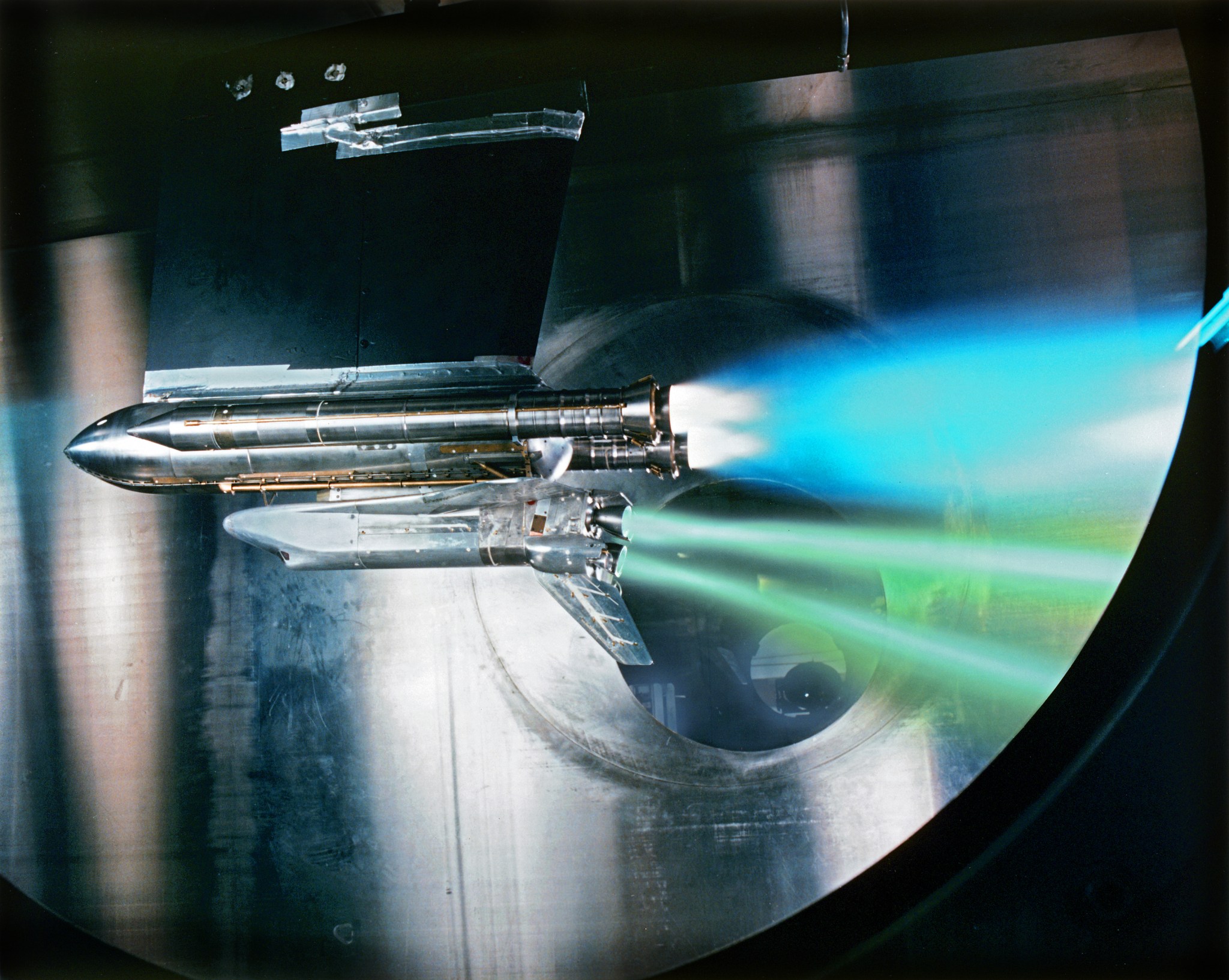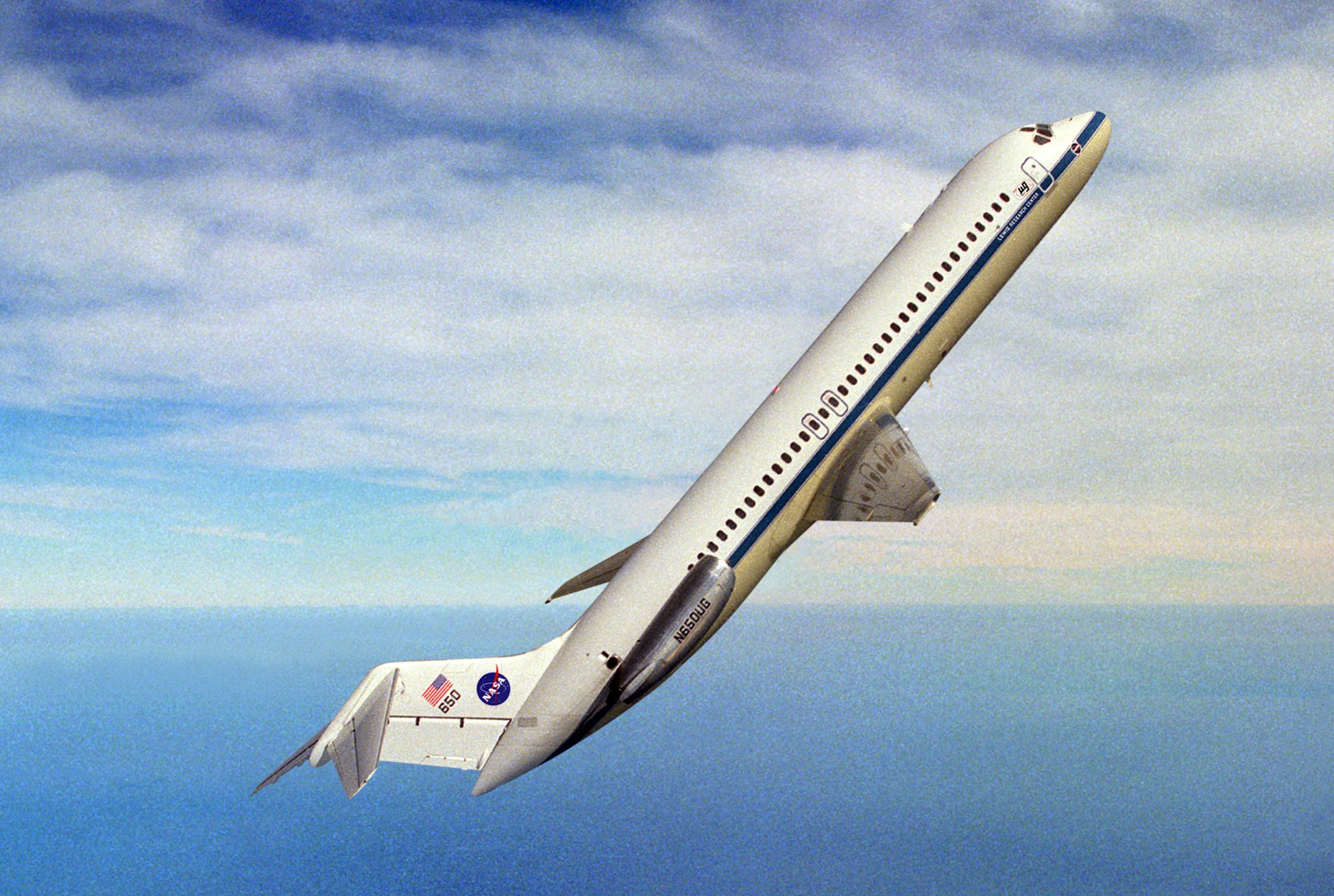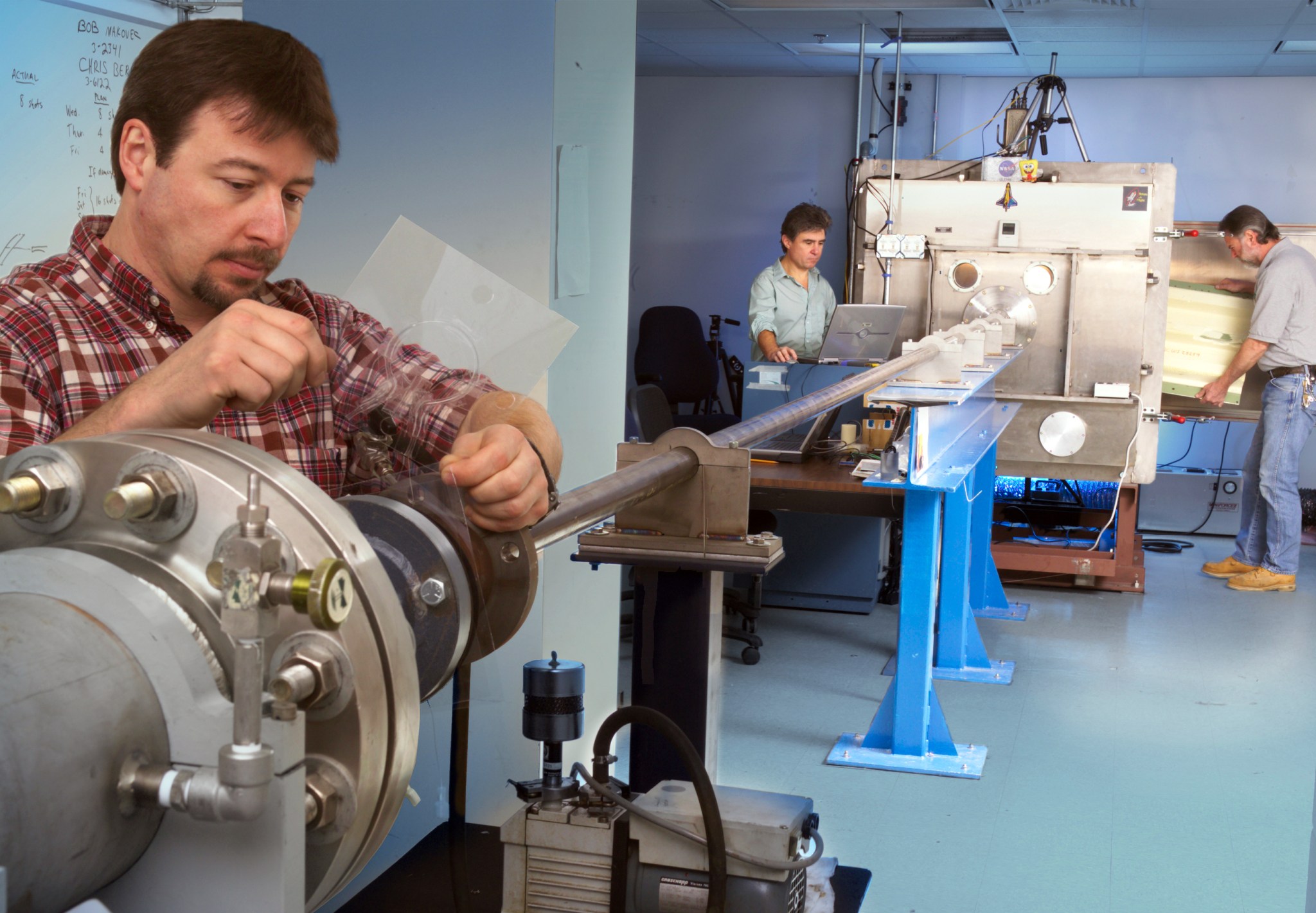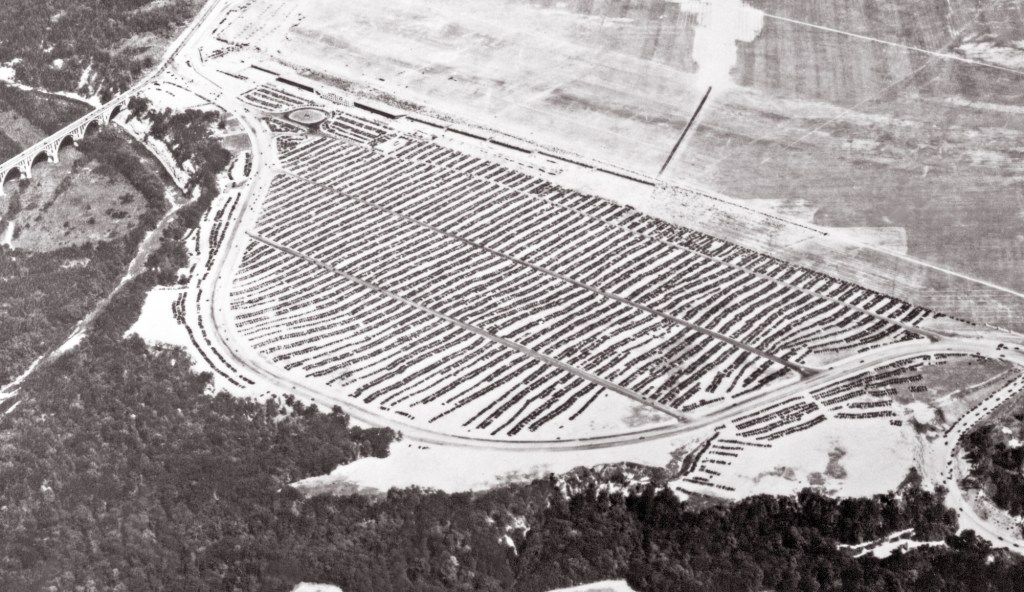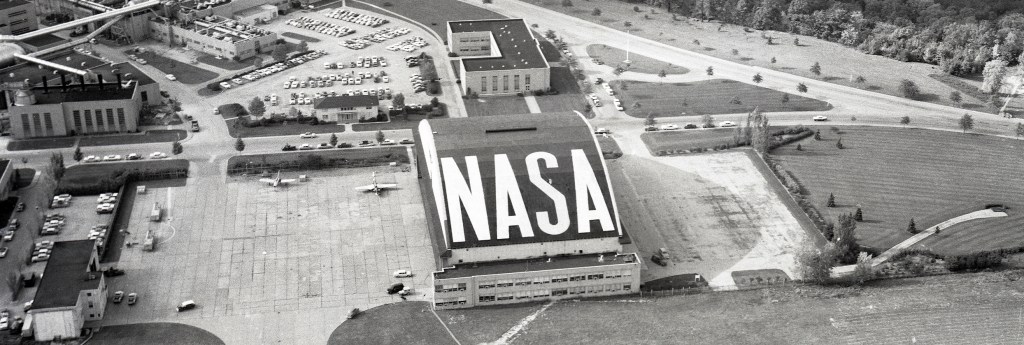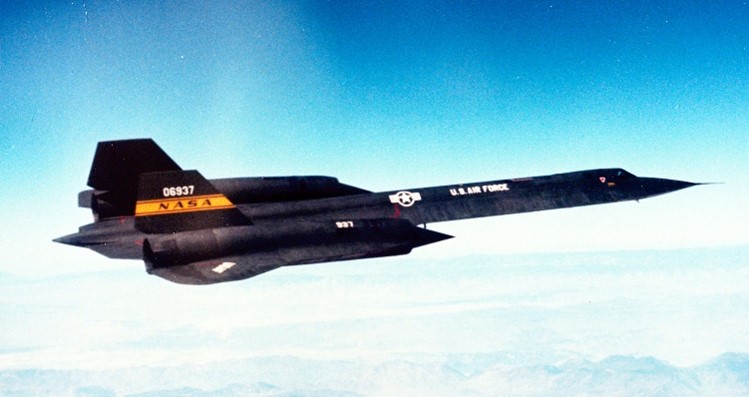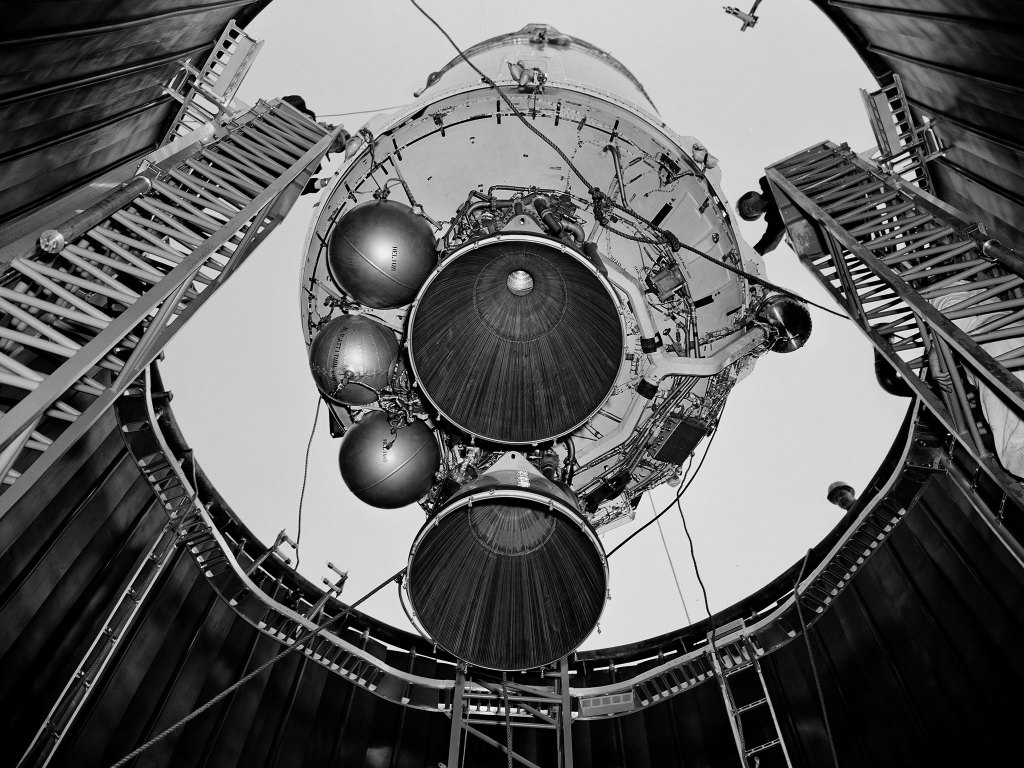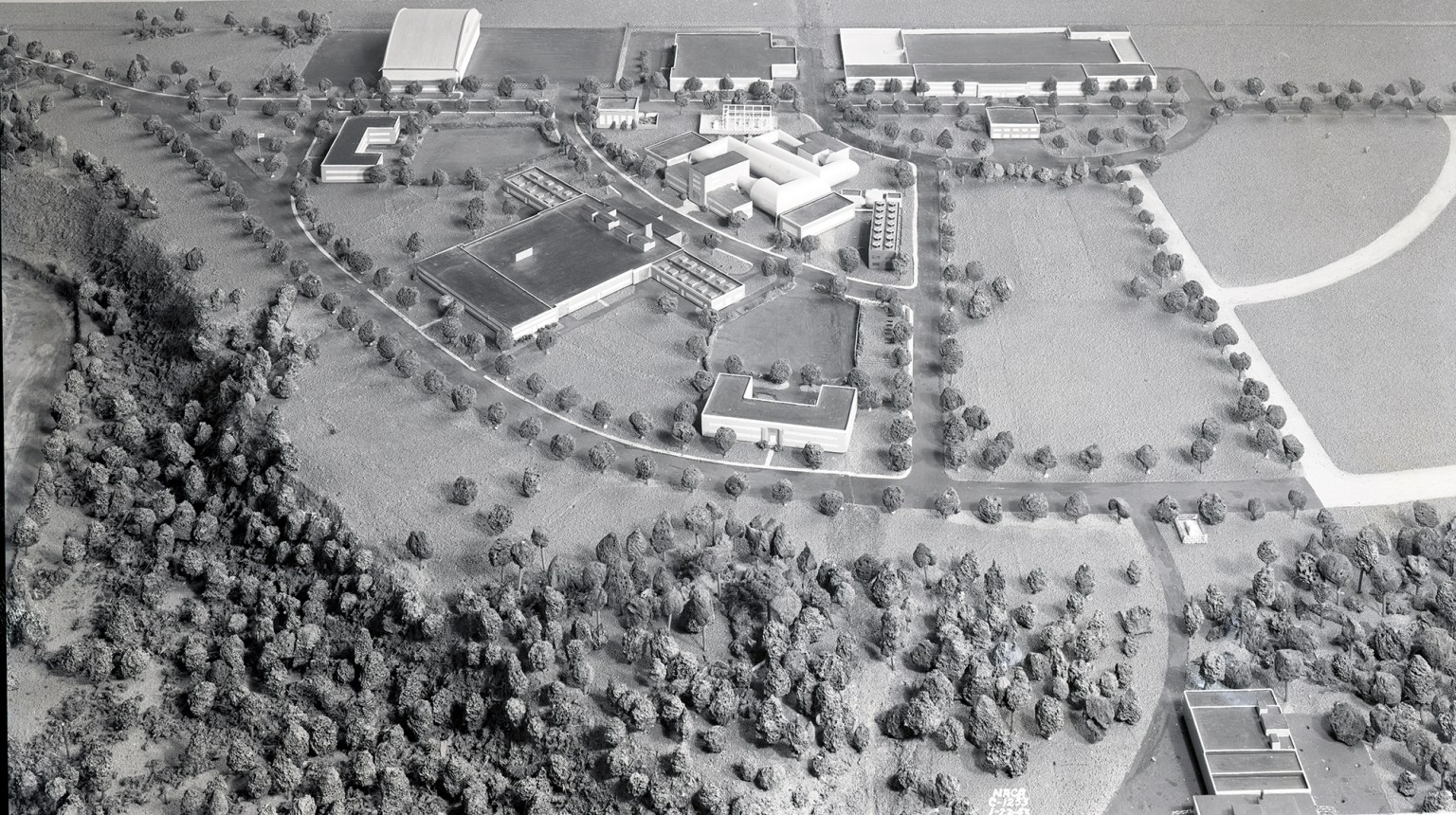
Glenn Historical Timeline
NASA’s Glenn Research Center, once a cluster of facilities dedicated exclusively to advancing aircraft propulsion systems, is now a sprawling campus employing scientific experts in world class propulsion, communications, power, and materials research.
Glenn History
Summary
For decades, our scientists and engineers have advanced technology in both aviation and space exploration. These innovations have given the U.S. a leading role in the aerospace industry.
1940s – The Beginning
The National Advisory Committee for Aeronautics (NACA) transforms the site of the National Air Races in Cleveland into a world-class Aircraft Engine Research Laboratory (AERL), which quickly makes contributions to the World War II effort.
1940 – The NACA announces on November 25 that it will build a new laboratory in Cleveland.
1941 – Groundbreaking ceremony for the AERL takes place on January 23.
1942 – E. Raymond Sharp officially named laboratory manager on December 1.
1943 – First research flight takes place on March 17 with a Martin B-26. AERL dedication ceremony held on May 20.
1944 – First test is performed in the Altitude Wind Tunnel with a jet engine. Construction of the Icing Research Tunnel is completed.
1945 – Lab’s first supersonic wind tunnel begins operation in June. AERL undergoes major reorganization in October to focus on jet propulsion.
1946 – Post-war visitors include Dwight Eisenhower, Curtis LeMay, Frank Whittle and James Doolittle.
1948 – In honor of the late George Lewis, the lab’s name changed to NACA Lewis Flight Propulsion Laboratory.
1949 – 8-by-6 Foot Supersonic Wind Tunnel begins operation on April 3. First sponsored rocket testing at the lab is conducted for the Navy. Abe Silverstein is appointed Chief of Research and reorganizes the staff.
1950s – New Types of Propulsion
The laboratory’s research activities are reorganized to focus on high energy rocket propellants and nuclear propulsion. The launch of Sputnik in the fall of 1957 leads to the lab’s incorporation into the new NASA space agency.
1950 – New water droplet system for the the Icing Research Tunnel is perfected.
1951 – Initiation of transonic compressor research.
1952 – Abe Silverstein is appointed Associate Director. Propulsion Systems Laboratory No. 1 and 2 begins operation.
1953 – Lewis researchers receive safety award for their full-scale aircraft crash investigations.
1954 – First firing of a liquid hydrogen-oxygen engine takes place at the Rocket Lab.
1955 – Neil Armstrong begins his NASA career as a test pilot at Lewis. Silverstein co-authors report on the potential use of liquid hydrogen as a jet fuel.
1956 – The NACA breaks ground for the Plum Brook Reactor facility. The 10-by 10-Foot Supersonic Wind Tunnel is dedicated and conducts testing of the inlet system for the world’s first supersonic bomber.
1957 – Lewis conducts first flights of a hydrogen-powered aircraft. Lewis staff discusses rocket work and space missions at the NACA’s 1957 Inspection. Lewis staff make recommendations for the NACA’s role in the space program. Rocket Engine Test Facility begins operation.
1958 – Laboratory incorporated into the new NASA space agency as the Lewis Research Center. NASA leases additional acreage at Plum Brook Station to construct the Rocket Systems Area facilities. Lewis acquires the West Area property and the Guerin House.
1959 – The center assembled and tested the Big Joe capsule for Project Mercury. President Eisenhower approves official NASA seal designed by James Modarelli.
1960s – The Space Program
The center contributes to the space program with a series of tests for Project Mercury, an intensive study into the storage and handling of liquid hydrogen, and management of the Centaur upper-stage rocket. By the late 1960s, the center was again shifting back toward aeronautics.
1960 – Mercury 7 astronauts, including John Glenn, train in Lewis’ Multiple Axis Space Test Inertia Facility (MASTIF). Space Nuclear Propulsion Office (SNPO) created with Lewis responsible for engine technology. Retirement of Center Director Raymond Sharp.
1961 – Abe Silverstein is named Center Director. Electric Propulsion Laboratory begins operation. Plum Brook Reactor Facility goes critical for first time.
1962 – Transfer of the Centaur upper stage rocket program to Lewis. Center hosts NASA’s largest public exhibition to date at Public Hall.
1963 – Transfer of the Agena upper stage rocket program to Lewis. Lewis manages first successful Centaur rocket launch (AC-2). NASA formally acquires Plum Brook Station from the Army.
1964 – Space Electric Rocket Test (SERT I) conducts the first in-space ion thruster test. Stephen Papell invents magnetic fluids, leading to the creation of a ferrofluids industry. Opening of the Development Engineering Building in the North Area.
1965 – Cryogenic Tank Facility (K Site) begins operation at Plum Brook.
1966 – Atlas Centaur-8 becomes the first successful two-burn Centaur. Atlas-Centaur-10 launches the Surveyor spacecraft to the Moon. Center celebrates its 25th anniversary and hosts an Inspection for 2000 invited guests. Zero Gravity Facility begins operation.
1967 – Irving Pinkel participates in the Apollo 1 fire investigation
1968 – 9-by 15-Foot Low Speed Wind Tunnel begins operation.
1969 – Atlas Centaur rockets launch Mariner 6 and 7 flyby missions to Mars. Bruce Lundin becomes Lewis’ third center director. Completion of the Space Power Facility and Space Propulsion Research Facility.
1970s – Quiet Engines and Loud Rockets
Cutbacks to traditional aerospace programs spurred the center to explore new areas of research such as renewable energy and communication satellites. Aeropropulsion work concentrated on noise and emissions reductions. The center’s most high-profile successes during the 1970s were the Titan-Centaur launches of Viking and Voyager spacecraft.
1970 – Launch of the second Space Electric Rocket Test (SERT II). Lewis performs combustion testing to support the Apollo 13 investigation.
1971 – YF-12 Blackbird inlet testing conducted in the 10-by 10-foot Supersonic Wind Tunnel. NASA establishes the Aerospace Safety Research and Data Institute at Lewis.
1972 – Launch (AC-27) of Pioneer 10, the first man-made object to leave the solar system. The Propulsion Systems Laboratory No. 3 and 4 begins operation.
1973 – NASA cancels its nuclear programs, resulting in layoffs of hundreds of Lewis employees. Shutdown of Plum Brook Station begins with the closure of the reactor facility. Lewis’ Wind Energy Conversion Workshop spurs wind turbine development program.
1974 – First successful launch Titan-Centaur launch sends Helios 1 on mission to the sun.
1975 – Titan-Centaur launches the Viking 1 and 2 spacecraft to Mars. Dedication of the Mod-0A wind turbine at Plum Brook Station.
1976 – Launch of the Lewis-managed Communications Technology Satellite (CTS). Prop testing for the Advanced Turboprop Program begins in the 8-by-6 Wind Tunnel.
1977 – Titan-Centaur launches Voyager 1 and 2 on missions to explore the outer solar system. The Cleveland Clinic begins using the Lewis Cyclotron for its Neutron Therapy Program.
1978 – John McCarthy becomes the fourth Lewis center director. Lewis activates the world’s first solar electric village in Schuchuli, Arizona. Dedication of the Lewis Visitors Information Center.
1979 – Peak of Lewis’ wind energy research efforts.
1980s – The Shuttle Era Begins
NASA Lewis becomes responsible for several new, mainstream agency programs, including the space station power system, the Shuttle/Centaur upper-stage vehicle, and the Advanced Communications Technology Satellite (ACTS).
1980 – Dedication of the Research Analysis Center (RAC). Isidore Warshawsky becomes the first NASA employee with 50 years of service.
1981 – Center is assigned responsibility for the Shuttle-Centaur program.
1982 – Andy Stofan becomes Lewis’ fifth center director. The Center’s first strategic plan is issued.
1983 – Lewis makes first significant staffing increase in nearly 20 years.
1984 – Center is assigned responsibility for the space station power system.
1985 – Lewis holds first Simulated Shuttle Program for local students.
1986 – Cancellation of the Shuttle-Centaur program. Reactivation of the Space Power Facility begins at Plum Brook Station.
1987 – The Icing Research Tunnel is designated an ASME Historic Engineering Landmark . John Klineberg becomes Center Director. NASA wins Emmy for developing the Communications Technology Satellite.
1988 – Advanced Turboprop team receives Robert J. Collier Trophy on May 13.
1989 – Space Electric Rocket Test (SERT II) is reactivated nearly 20 years after its launch. Dedication of the Power Systems Facility to support the space station program. Atlas-Centaur 68 is the last Lewis-managed commercial Centaur launch.
1990s – A New Name
The Center continues its leading aeropropulsion, space power and space propulsion work. Lewis becomes program manager for Fluid Physics and Combustion Microgravity Research.
1990 – Larry Ross becomes Lewis Center Director.
1991 – Center celebrates its 50th anniversary. Dedication of new Edward R. Sharp Employee Center.
1992 – 1-by 1-Foot Supersonic Wind Tunnel reaches 5,000 hours of run time. Joseph Nieberding travels to Moscow to explore the use of Russian spacecraft for the space station. Dedication of the Ohio Aerospace Institute.
1993 – Center given responsibility for propulsion system for the new High Speed Research program. Lewis staff help transition Space Station Freedom into the International Space Station. STS-51 deploys the Advanced Communications Technology Satellite (ACTS).
1994 – Donald Campbell is appointed Center Director.
1995 – Delivery of Lewis-managed Mir Cooperative Solar Array to Russian space station Mir. Lewis rolls out DC-9 aircraft modified for microgravity research.
1996 – Deployment of Lewis-managed Mir Cooperative Solar Array on Mir.
1997 – Mars Pathfinder lands on the Martian surface with Lewis experiments. Last Lewis-managed Centaur launch sends the Cassini spacecraft toward Saturn.
1998 – Launch of Deep Space I powered by Lewis’ NSTAR ion thruster.
1999 – The center is renamed the John H. Glenn Research Center.
2000s – The 21st Century
The center makes key contributions to the Columbia Accident Investigation and Constellation Project. The campus also undergoes transformation with the addition of the Mission Integration Center and the removal of several historic facilities.
2000 – Dedication of the Ballistics Lab in the Materials and Structures Building. Glenn-designed solar arrays are delivered to the International Space Station.
2001 – STS-107 crew visits Glenn to train on the Combustion Module-2.
2002 – Graphics and Visualization (GRUVE) Lab and Telescience Support Center facilities open.
2003 – Julian Earls becomes Center Director. Ballistics Lab performs impact testing for the Columbia accident investigation.
2004 – Center formally acquires the S-3 Viking aircraft.
2005 – Woodrow Whitlow becomes Glenn Center Director.
2006 – NASA assigns Glenn responsibility for Orion service module.
2007 – Rededication of the Space Power Facility (SPF). Launch of the NSTAR thruster-powered Dawn asteroid mission
2008 – Demolition of the Altitude Wind Tunnel commences. Assembled Ares I-X segments leave Glenn for delivery to Kennedy Space Center.
2009 – Commercial Aviation Safety Team Robert J. Collier Trophy. Glenn-designed Ares I-X Upper Stage Simulator is successfully launched.
2010 – NASA Glenn Visitor Center moves to Great Lakes Science Center. Ramon Lugo becomes center director.
2011 – Dedication of the new main gate and security building.
2012 – Space Communications and Navigation (SCaN) sent to the ISS.
2013 – Jim Free becomes Glenn Center Director. NEXT thruster completes record-setting 5 1/2-year duration test.
2014 – Glenn dedicates new Mission Integration Center building.
2015 – The center inducts first class into the Glenn Hall of Fame.
2016 – Janet Kavandi becomes Center Director. Orion Crew Module acoustics testing conducted at the Space Power Facility.
2017 – Glenn celebrates its 75th anniversary.
2018 – Orion spacecraft for Artemis I is tested at the Space Power Facility.
2019 – Software Defined Radio team inducted into Space Technology Hall of Fame.
2020 – Dr. Marla E. Pérez-Davis becomes center director. Plum Brook Station is renamed the Neil Armstrong Test Facility.
2022 – Research Support Building opens. James Kenyon becomes Center Director.





























